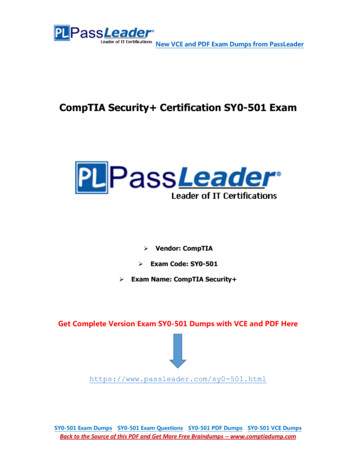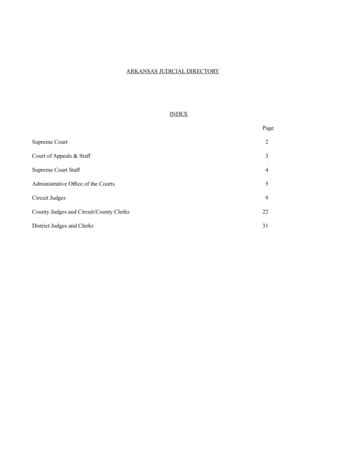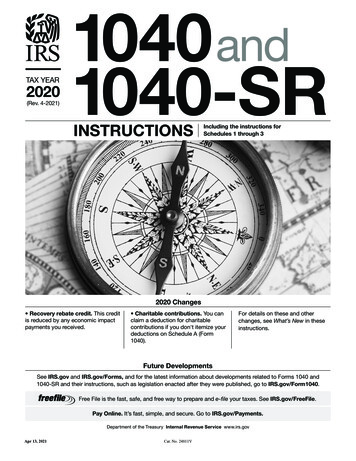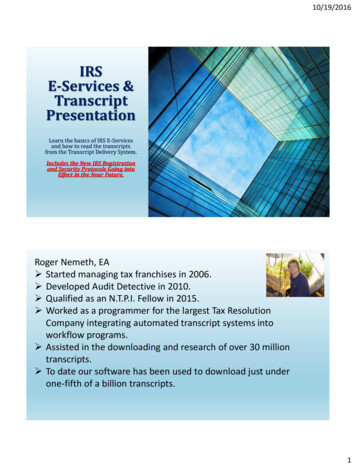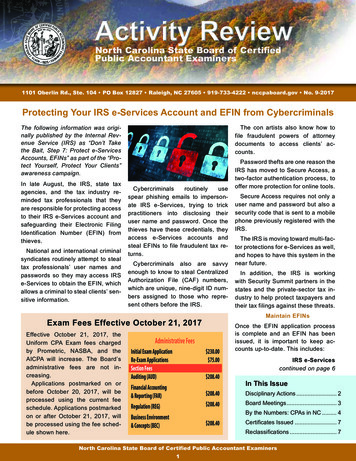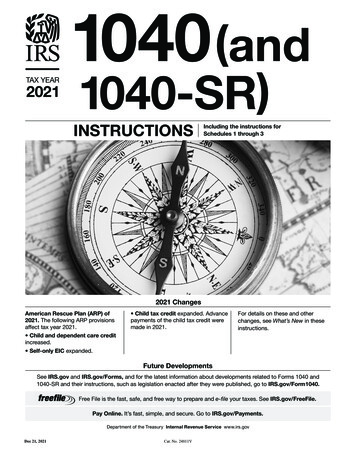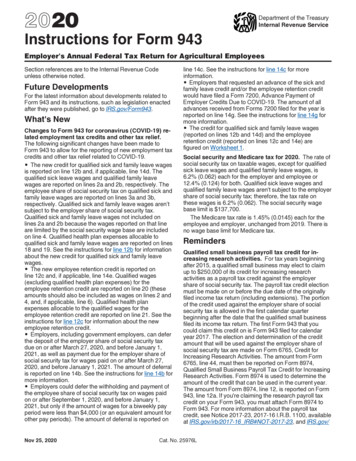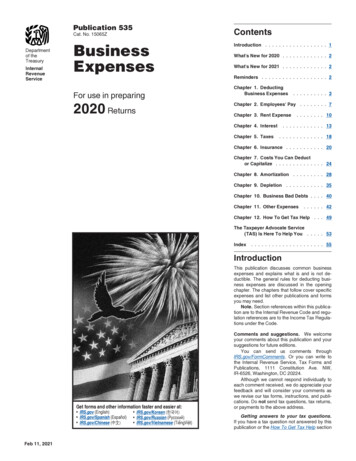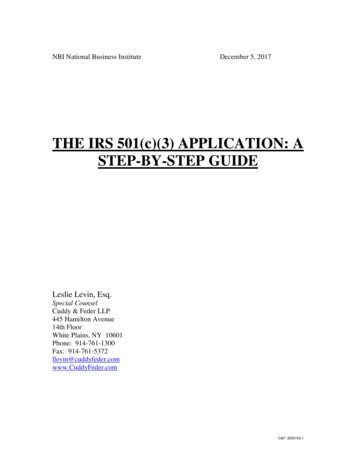
Transcription
NBI National Business InstituteDecember 5, 2017THE IRS 501(c)(3) APPLICATION: ASTEP-BY-STEP GUIDELeslie Levin, Esq.Special CounselCuddy & Feder LLP445 Hamilton Avenue14th FloorWhite Plains, NY 10601Phone: 914-761-1300Fax: mC&F: 3550102.1
Determining Eligibility and Deciding on Public Charity vs PrivateFoundation ClassificationThe client may give an unlimited amount to a qualifying charity which is anorganization described in §§170(6)(1)(A), 170(c) and 2055(a) of the Internal RevenueCode of 1986, as amended (the "Code"). There is no gift or estate tax because thetransfer qualifies for a charitable deduction. These not-for-profit corporations must havea charitable purpose and in New York, three directors are required. They are also called501(c)(3) organizations and can be divided into two classes: private foundations andpublic charities.Private foundations typically have a single major source of funding (usually giftsfrom one family or corporation) and most have as their primary activity the making ofgrants to other charitable organizations and to individuals, rather than the direct operationof charitable programs. The benefits of such an organization are control over investmentsand distributions, family involvement to ensure a legacy of family giving, immediate taxdeduction for contributed assets (even though foundation does not distribute all of theassets immediately to other charities) and removal of low basis taxable assets out ofestate without incurring capital gains taxes. The tax deduction is limited to 30% ofadjusted gross income (AGI) for cash donations to the private foundation and 20% ofAGI for appreciated securities.The Donor can carry forward any of the unuseddeduction for an additional 5 tax years. For valuation of the contributed asset, gifts ofclosely held stock held more than a year will be deductible only in the amount of thedonor’s basis.All records are open to the public.Directors can receive compensation.However, there are some disadvantages to operating a private foundation. Directors mustrefrain from acts of self-dealing (§4941 of the Code), meet minimum distributionrequirements of distributing 5% of its assets each year to other charitable causes (§4942of the Code), abstain from "excess business holdings" (§4943 of the Code), abstain from"jeopardizing investments" (§4944 of the Code), refrain from making certainC&F: 3550102.1
expenditures (§4945 of the Code) and pay tax on net investment income (§4940 of theCode).For clients interested in an entity that expands its scope from the single familyfocus, a public charity may be a better choice of entity. Generally, public charities areorganizations that meet the following criteria which can be found in §§509(a)(1), (2), (3)or (4) of the Code:(i)Churches, hospitals, qualified medical research organizations affiliatedwith hospitals, schools, colleges and universities;(ii)Fundraise and receive contributions from many sources, including thegeneral public, governmental agencies, corporations, private foundations or otherpublic charities;(iii)Receive income from activities in furtherance of the organization’sexempt purposes; or(iv)Actively function in a supporting relationship to one or more existingpublic charities.The tax deduction is limited to 50% of AGI for cash donations to a public charityand 20% of AGI for appreciated securities. The Donor can carry forward any of theunused deduction for an additional 5 tax years. For valuation of the contributed asset,gifts of closely held stock held more than a year will be deductible in the amount of itsfair market value which is substantially better than the valuation offered for gifts to aprivate foundation.All records are open to the public.Directors can receive compensation.Additionally, §642(c) of the Code allows public charities to establish and maintainpooled income funds. At least one-third of the funding must come from a governmentalunit or from direct or indirect contributions from the general public. The percentages arecalculated by using total support as the denominator and public support as the numerator.The numbers used reflect a four year period. Public support can also come from grossreceipts derived from an activity related to its exempt purpose. If the entity fails the onethird support test, then it can still qualify as a public charity under the facts andC&F: 3550102.1
circumstances 10% test. Under this test, the organization must normally receive at least10% of the total support from governmental units, from contributions made directly orindirectly by the general public, or a combination of the two. Additionally, the entitymust maintain a continuous and bona fide program for solicitation of funds from thegeneral public, community, or membership group involved, or it can carry on activitiesdesigned to attract support from governmental units or other charitable organizationsdescribed in §509(a)(1) of the Code. This test also uses a four year period.Before proceeding with incorporating an entity and securing tax exempt status,clients should provide certain information which will be needed throughout the variousformation steps.The attorney may wish to hold several meetings to gather thisinformation or use a memo provided to the client at an initial meeting or before the initialclient meeting (see Exhibit A).In order to create a not-for-profit organization in New York that is exempt fromfederal income taxation, the client must take the following steps:1)Creating an organization under state law.Not-for-Profit organizations aregoverned in New York under the New York Not-For-Profit Corporation Law. The entitymust be a corporation formed with a charitable purpose. To create the entity, you must:A)File a Certificate of Incorporation with State of New York Department ofState (see later discussions in these materials for sample and discussion). If thereis an educational component to the planned charitable purpose, you must firstsecure a Consent to Filing with the Department of State from the State of NewYork Department of Education.For proper formation, a minimum of threedirectors are required. These three individuals are the initial directors and can bechanged following incorporation.B)Following incorporation, the entity must be assigned a tax identificationnumber (EIN). If you are applying on behalf of your client, then you should havethe client sign an authorization form (Form SS-4 and authorization form attachedas Exhibit B and see discussion under “Obtaining a Federal EIN” in theseC&F: 3550102.1
materials). You can apply on-line for an EIN by going to the IRS website:www.irs.gov and you can also find the Form SS-4 on this website.C)Create By-Laws (see later discussions in these materials for sample anddiscussion). The By-Laws serve as a road map for how to govern the entity.They must be adopted by the initial Directors.D)Meeting of the Board of Directors to certify that the certificate ofincorporation was filed with the Department of State, to adopt the By-Laws and toelect directors.This meeting, and any other meetings, can be avoided bycompleting a form of unanimous consent signed by all of the directors (SeeExhibit C for sample form).E)Meeting of the Board to approve acts of initial directors, elect officers andtake initial governing steps such as authorization for payment of fees andauthorization to apply for tax exempt status (See Exhibit D for sample form).F)Meeting of the Board to approve a Conflict of Interest Policy whichregulates the financial interests of the Officers and Directors. This form is nowrequired by the IRS and must be provided each year to each officer and director(see later discussions in these materials for sample and discussion as well ascertain forms at Exhibit E and F).2)Apply for Federal Income Tax Exemption. Pursuant to the IRS website, "To betax-exempt under section 501(c)(3) of the Code, an organization must be organized andoperated exclusively for exempt purposes set forth in section 501(c)(3) of the Code, andnone of its earnings may inure to any private shareholder or individual. In addition, itmay not be an action organization, i.e., it may not attempt to influence legislation as asubstantial part of its activities and it may not participate in any campaign activity for oragainst political candidates."A)Complete Form 1023 and attach related exhibits.The form andinstructions can be found on the IRS website: www.irs.gov (see later discussionsin these materials at “Completing Form 1023” for discussion as well as ExhibitG). Among the Exhibits will be the Federal Power of Attorney Form - Form 2848C&F: 3550102.1
(see Exhibit H). Without this form, the attorney will not be able to communicatewith the IRS during the tax exempt application process.B)Process can take many months.See discussion at “IRS ProcessingProcedures” later in these materials.C)Attorney and/or client may wish to read IRS Publications 4220 Applyingfor 501(c)(3) Tax-Exempt Status and 557 Tax-Exempt Status for YourOrganization for additional information before beginning process.3)Register with the New York State Attorney General Charities Bureau bycompleting the Form CHAR410 Registration Statement for Charitable Organizations andattach related exhibits. The form and instructions can be found on the Office of the NewYork State Attorney General website: www.oag.state.ny.us. Among the Exhibits will bethe New York Power of Attorney Form - Form POA-1. Without this form, the attorneywill not be able to communicate with the Attorney General's office during the tax exemptapplication process. The Attorney General's office will post copies of all formationdocuments on its website for public viewing. I note that this New York example isprovided for purposes of illustration of one state’s procedure. Each state will have itsown requirements.Drafting Organizational DocumentsClients often wish to create their own charitable entities. The first step in thisprocess is to draft the Articles of Incorporation (also called Certificate of Incorporationand used interchangeably in these materials) which must be filed with the state where theentity will be located. This Articles of Incorporation is the corporation’s organizingdocument and is governed by both state law and federal law. The drafter must bemindful that the document meets both criteria and should be aware that state lawrequirements differ. Each state’s law must be consulted before drafting.The application for securing tax exempt status for one’s organization is the Form1023 Application for Recognition of Exemption Under Section 501(c)(3) of the InternalRevenue Code and must be filed within 27 months from the end of the month in which itC&F: 3550102.1
was organized. In addition to the Form itself, the Application requires many exhibits.Among them is the entity’s Articles of Organization as the Form requires that the clientsubmit proof that the Articles of Incorporation were filed with the state by including acopy of the certification of filing showing the date they were filed and approved by thestate authority. Part II of the Form 1023 at page 2, Question 1, asks: “Are you acorporation? If “Yes,” attach a copy of your articles of incorporation showingcertification of filing with the appropriate state agency. Include copies of anyamendments to your articles and be sure they also show state filing certification.” IRSPublication 557, Tax-Exempt Status for Your Organization, provides that “a stamped“Filed” copy dated by the Secretary of State is prima facie evidence that it was filed andapproved by a state official.A copy of the Articles of Incorporation can also besubmitted with a written declaration signed by an authorized individual indicating thecopy is complete and was filed and approved by the state, including the date filed.Pursuant to the Instructions for Form 1023 at page 7, the IRS requires that theArticles of Incorporation include the following items:1) Name of entity2) Statement of exempt purpose3) Dissolution clause4) Date the document was adopted5) 2 signatures (for unincorporated association)Part III of the Form 1023 Required Provisions in Your Organizing Document atpage 2, Question 1, requires that the client confirm that the Articles of Organization statethe entity’s “exempt purpose(s), such as charitable, religious, educational, and/orscientific purposes.” Therefore, the preparer of the Form must also describe specificallywhere the Purpose clause can be found in the Articles by page, article and paragraph. Inorder to meet this requirement, the draftsman must be careful when crating the Articles ofIncorporation to (a) limit the corporation’s purposes to those described in section501(c)(3) of the IRC; (b) not expressly permit activities that do not further the entity’sC&F: 3550102.1
exempt purpose(s), i.e., unrelated activities; and, (c) permanently dedicate its assets toexempt purposes.Part III of the Form 1023 Required Provisions in Your Organizing Document atpage 2, Question 2, provides that the client confirm that the Articles of Organization statethat “upon dissolution of your organization, your remaining assets must be usedexclusively for exempt purposes, such as charitable, religious, educational, and/orscientific purposes.” Therefore, the drafter must also describe specifically where theDissolution clause can be found in the Articles by page, article and paragraph.Alternatively, if the entity is incorporated in Arkansas, California, Louisiana,Massachusetts, Minnesota, Missouri, Ohio or Oklahoma, the drafter can provide that theentity relies on state law for its dissolution provision and the drafter must provide whichstate governs this provision. Revenue Procedure 82-2, 1982-1 C.B. 367, identifies thestates and circumstances in which the IRS will not require an express provision for thedistribution of assets upon dissolution in the articles of organization.If the Articles of Incorporation do not contain 2 signatures “you may submit awritten declaration that states your copy is a complete and accurate copy of the signedand dated original. Your declaration should clearly indicate the original date ofadoption.” Instructions for Form 1023 at page 7.Code Section 501(c)(3) governs the federal not for profit law and provides thatthe following organizations shall be exempt from taxation:Corporations, and any community chest, fund, or foundation, organizedand operated exclusively for religious, charitable, scientific, testing forpublic safety, literary, or educational purposes, or to foster national orinternational amateur sports competition (but only if no part of itsactivities involve the provision of athletic facilities or equipment), or forthe prevention of cruelty to children or animals, no part of the net earningsof which inures to the benefit of any private shareholder or individual, nosubstantial part of the activities of which is carrying on propaganda, orotherwise attempting, to influence legislation (except as otherwiseprovided in subsection (h)), and which does not participate in, or intervenein (including the publishing or distributing of statements), any politicalcampaign on behalf of (or in opposition to) any candidate for publicoffice.C&F: 3550102.1
Therefore, in order to secure tax exempt status, an organization must have one or more ofthose exempt purposes stated in its Articles of Organization. The IRS provides samplelanguage in the instructions for the Form 1023 as follows:“The organization isorganized exclusively for charitable, religious, educational, and scientific purposes undersection 501(c)(3) of the Internal Revenue Code, or corresponding section of any futurefederal tax code.”IRS Publication 4220, Applying for 501(c)(3) Tax-Exempt Status at pages 4through 6, provides that the most common types of 501(c)(3) organizations are charitable,educational, and religious.a)Charitable organizations conduct activities that promote:- relief of the poor, the distressed, or the underprivileged,- advancement of religion,- advancement of education or science,- erection or maintenance of public buildings monuments, or works,- lessening the burdens of government,- lessening neighborhood tensions,- eliminating prejudice and discrimination,- defending human and civil rights secured by law,- combating community deterioration and juvenile delinquencyb)Educational organizations include:- schools such as a primary or secondary school, a college, or aprofessional or trade school,- organizations that conduct public discussion groups, forums, panels,lectures, or similar programs,- organizations that present a course of instruction by means ofcorrespondence or through the use of television or radio,- museums, zoos, planetariums, symphony orchestras, or similarorganizations,- nonprofit day-care centers,- youth sports organizationsc)Religious organizations include churches, synagogues, temples, mosques,and similar types of organizations.C&F: 3550102.1
Although the Code does not require that religious organizations file aForm 1023, many do in order to have the tax determination letter which offersreassurance to donors that the entity is tax exempt under section 501(c)(3) of theCode. Certain religious organizations do need to file a Form 1023 and they are:mission organizations, speakers’ organizations, nondenominational ministries,ecumenical organizations, and faith-based social agencies. In essence if the entitymeets the following criteria, it will count as a religious organization:1)That the particular religious beliefs of the organization are trulyand sincerely held.2)That the practices and rituals associated with the organization'sreligious belief or creed are not illegal or contrary to clearly defined public policy.An additional resource for religious organizations is IRS Publication 1828, TaxGuide for Churches and Religious Organizations.By merely stating one of the above purposes in the Articles of Incorporation is sufficientto limit the purpose of the entity to a tax exempt purpose. For example by stating thepurpose of the organization is “relief of the poor” would properly limit its tax exemptpurpose. Additionally, the Articles can limit its tax exempt status purpose by stating forexample, “relief of the elderly within the meaning of section 501(c)(3).” Instructions forForm 1023 at page 7. Additionally, providing that in the event of dissolution the assetsare given to a 501(c)(3) organization, the Articles of Incorporation provide that the assetsare permanently dedicated to its exempt purposes.IRS Publication 557 at page 24 provides that the articles of organization mustlimit the organization's purposes to one or more of the ones stated in 501(c)(3) of theCode, and described more fully in this section, and must not state that the entity can carryon activities that do not further one or more of those purposes. This criteria is called theorganizational test. State law governs how the Articles of Incorporation is interpreted indetermining whether this organizational test is met.At page 25, Publication 557 provides eight examples of what satisfies the criteriato have a tax exempt purpose in the entity’s Articles of Incorporation. The examples are:C&F: 3550102.1
Example 1. Articles of organization state that an organization is formed exclusively forliterary and scientific purposes within the meaning of section 501(c)(3). These articlesappropriately limit the organization's purposes. The organization meets the organizationaltest.Example 2. An organization, by the terms of its articles, is formed to engage in researchwithout any further description or limitation. The organization will not be properlylimited as to its purposes since all research is not scientific. The organization does notmeet the organizational test.Example 3. An organization's articles state that its purpose is to receive contributions andpay them over to organizations that are described in section 501(c)(3) and exempt fromtaxation under section 501(a). The organization meets the organizational test.Example 4. If a stated purpose in the articles is the conduct of a school of adult educationand its manner of operation is described in detail, such a purpose will be satisfactorilylimited.Example 5. If the articles state the organization is formed for charitable purposes,without any further description, such language ordinarily will be sufficient since the termcharitable has a generally accepted legal meaning. On the other hand, if the purposes arestated to be charitable, philanthropic, and benevolent, the organizational requirement willnot be met since the terms philanthropic and benevolent have no generally accepted legalmeaning and, therefore, the stated purposes may, under the laws of the state, permitactivities that are broader than those intended by the exemption law.Example 6. If the articles state an organization is formed to promote American ideals, orto foster the best interests of the people, or to further the common welfare and well-beingof the community, without any limitation or provision restricting such purposes toaccomplishment only in a charitable manner, the purposes will not be sufficiently limited.Such purposes are vague and may be accomplished other than in an exempt manner.Example 7. A stated purpose to operate a hospital does not meet the organizational testsince it is not necessarily charitable. A hospital may or may not be exempt depending onthe manner in which it is operated.Example 8. An organization that is expressly empowered by its articles to carry on socialactivities will not be sufficiently limited as to its power, even if its articles state that it isorganized and will be operated exclusively for charitable purposes.Each state has provisions to check whether a name is available for use by theentity which typically can be found on each state’s respective Secretary of State website.Names must be distinguishable from existing names on file for other corporations.C&F: 3550102.1
In New York, the proper process for checking whether a name is available for acorporation, is to make a name availability inquiry. An online search for names in use byexisting entities can be made at: http://www.dos.ny.gov/corps/bus entity search.htmlwhich is the Corporation and Business Entity Database. Additionally, a written inquirystating a request for a determination of the availability of a name and list the name ornames to be searched can be made by submitting a written request to the Department ofState, Division of Corporations, One Commerce Plaza, 99 Washington Avenue, Albany,NY 12231. The response can be attached to the Certificate of Incorporation being filedwith the state. If the name is available, the name is still not approved until the Certificateis filed and accepted by the state. In Connecticut, you can check name availability /CONCORD/online?sn PublicInquiry&eid 9740N.Y. NPC. LAW § 303 allows for the reservation of the name for 60 days. Thecertificate of reservation shall include the name of the applicant, the name reserved andthe date of the reservation and shall be signed by the applicant, his attorney or agent. Thecertificate of reservation must accompany the certificate of incorporation when it is filed.In Connecticut, the name can be reserved by filing an Application for Reservation tion.pdfAs stated previously, each state has its own requirements and its statutes andforms should be reviewed before drafting. In general, the Articles of Incorporationcontain the following information:1.Name of corporation.In general, the name of the corporation mustcontain one of the following designations: "corporation", "incorporated", or "company",or the abbreviation "corp.", "inc." or "co." The name must also be distinguishable fromother business names on the records of the Secretary of the State. Additionally, thestatute contains a list of words not allowed to be used as they mislead the public. SeeN.Y. NPC. LAW § 301.C&F: 3550102.1
2.Statement of purpose.3.Location of office.4.Contact information for initial directors.5.Appointment of registered agent.6.Other information such as any information which the corporation ispermitted but not required to provide and can include IRS language. This space is wherethe corporation can provide the prohibitions found in 501(c)(3) of the Code which are asfollows:a) must absolutely refrain from participating in the political campaigns ofcandidates for local, state, or federal office;b) must restrict its lobbying activities to an insubstantial part of its totalactivities;c) must ensure that its earnings do not inure to the benefit of any privateshareholder or individual;d) must not operate for the benefit of private interests such as those of itsfounder, the founder’s family, its shareholders or persons controlled bysuch interests;e) must not operate for the primary purpose of conducting a trade orbusiness that is not related to its exempt purpose, such as a school’soperation of a factory; and,f) must not have purposes or activities that are illegal or violatefundamental public policy.7.Name and contact information for incorporator.8.Executed by incorporator.As stated previously, private foundations are subject to additional requirementsand the Articles of Incorporation should indicate that the Directors 1) must refrain fromacts of self-dealing (§4941 of the Code), 2) meet minimum distribution requirements ofdistributing 5% of its assets each year to other charitable causes (§4942 of the Code),3) abstain from "excess business holdings" (§4943 of the Code), 4) abstain fromC&F: 3550102.1
"jeopardizing investments" (§4944 of the Code), 5) refrain from making certainexpenditures (§4945 of the Code) and 6) pay tax on net investment income (§4940 of theCode). Good practice is to include these limitations if there is any risk that entity couldfail the public charity test and be construed as a private foundation. See N.Y. NPC. LAW§ 406.The requirements for the New York form of the Certificate of Incorporation arefound at N.Y. NPC. LAW § 402. Examples of acceptable forms are as follows:Federal Example found at page 71 of Publication 557 as icles of Incorporation of the undersigned, a majority of whom are citizens of theUnited States, desiring to form a Non-Profit Corporation under the Non-ProfitCorporation Law of , do hereby certify:First: The name of the Corporation shall be .Second: The place in this state where the principal office of the Corporation is to belocated is the City of , County of .Third: Said corporation is organized exclusively for charitable, religious, educational,and scientific purposes, including, for such purposes, the making of distributions toorganizations that qualify as exempt organizations under section 501(c)(3) of the InternalRevenue Code, or the corresponding section of any future federal tax code.Fourth: The names and addresses of the persons who are the initial trustees of thecorporation are as follows:NameAddressC&F: 3550102.1
Fifth: No part of the net earnings of the corporation shall inure to the benefit of, or bedistributable to its members, trustees, officers, or other private persons, except that thecorporation shall be authorized and empowered to pay reasonable compensation forservices rendered and to make payments and distributions in furtherance of the purposesset forth in Article Third hereof. No substantial part of the activities of the corporationshall be the carrying on of propaganda, or otherwise attempting to influence legislation,and the corporation shall not participate in, or intervene in (including the publishing ordistribution of statements) any political campaign on behalf of or in opposition to anycandidate for public office. Notwithstanding any other provision of these articles, thecorporation shall not carry on any other activities not permitted to be carried on (a) by acorporation exempt from federal income tax under section 501(c)(3) of the InternalRevenue Code, or the corresponding section of any future federal tax code, or (b) by acorporation, contributions to which are deductible under section 170(c)(2) of the InternalRevenue Code, or the corresponding section of any future federal tax code. If referenceto federal law in articles of incorporation imposes a limitation that is invalid in yourstate, you may wish to substitute the following for the last sentence of the precedingparagraph: “Notwithstanding any other provision of these articles, this corporationshall not, except to an insubstantial degree, engage in any activities or exercise anypowers that are not in furtherance of the purposes of this corporation.”Sixth: Upon the dissolution of the corporation, assets shall be distributed for one or moreexempt purposes within the meaning of section 501(c)(3) of the Internal Revenue Code,or the corresponding section of any future federal tax code, or shall be distributed to thefederal government, or to a state or local government, for a public purpose. Any suchassets not so disposed of shall be disposed of by a Court of Competent Jurisdiction of thecounty in which the principal office of the corporation is then located, exclusively forsuch purposes or to such organization or organizations, as said Court shall determine,which are organized and operated exclusively for such purposes.Seventh: If creating a private foundation, then add this Article. The corporation willdistribute its income for each tax year at a time and in a manner as not to become subjectto the tax on undistributed income imposed by section 4942 of the Internal RevenueCode, or the corresponding section of any future federal tax code. The
adjusted gross income (AGI) for cash donations to the private foundation and 20% of AGI for appreciated securities. The Donor can carry forward any of the unused deduction for an additional 5 tax years. For valuation of the contributed asset, gifts of closely held stock held more
